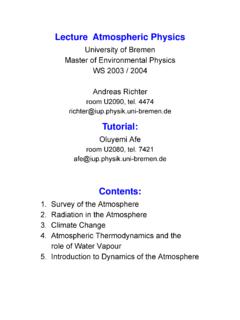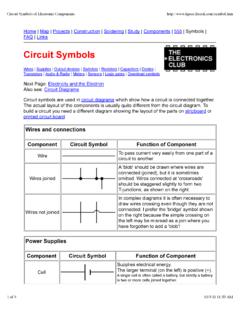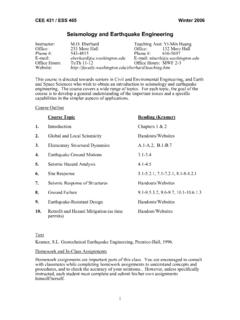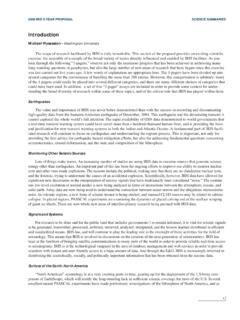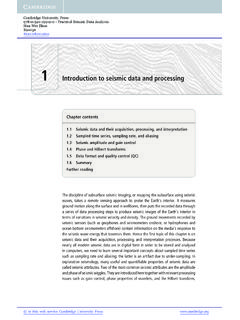Transcription of GE 162 Introduction to Seismology - www.gps.caltech.edu
1 California Institute of Technology Seismological Laboratory GE 162 Introduction to Seismology Lecture notes Jean Paul (Pablo) Ampuero Winter 2013 - 2016 GE 162 Introduction to Seismology Winter 2013 - 2016 1 Contents 1 Overview and 1D wave equation .. 5 Overview, etc .. 5 Longitudinal waves in a rod: derivation of the wave equation .. 5 Description of the problem and 5 Dynamics .. 6 Rheology .. 6 The 1D wave equation .. 6 2 1D wave equation: solution and main properties .. 8 General solution .. 8 Reflection at one end .. 8 Fourier transform .. 9 Harmonic waves .. 9 3 Energy, reflection/transmission, normal modes .. 11 Impedance .. 11 Energy considerations for harmonic waves .. 11 Reflection and transmission at a material interface.
2 11 Normal modes of a finite elastic rod .. 12 Duality between modes and propagating 13 4 Green s function. Waves in heterogeneous media.. 14 Linear invariant systems, Green s functions, convolution .. 14 Green s function for the 1D wave equation .. 14 Waves in heterogeneous medium (WKBJ approximation) .. 15 5 The 3D elastic wave equation .. 16 Strain .. 16 Stress .. 16 Momentum equation .. 16 Elasticity .. 16 The seismic wave equation .. 17 It s a perturbative equation .. 17 P and S waves examples .. 17 General decomposition into P and S waves .. 18 GE 162 Introduction to Seismology Winter 2013 - 2016 2 Polarization of body waves .. 18 Usual characteristics of body waves .. 19 6 Body waves .. 20 Spherical waves, far-field, near-field.
3 20 Ray theory: eikonal equation, ray tracing .. 20 Rays in depth-dependent media, Snell s law, refraction .. 21 7 More on body waves .. 22 Layer over half-space: head waves .. 22 A steep transition zone .. 23 A low velocity zone .. 23 Wave amplitude along a ray .. 25 Ray parameter in spherically symmetric Earth .. 25 Body waves in the Earth .. 25 8 Surface waves I: Love waves .. 30 Separation between SH and P-SV waves .. 30 SH reflection and transmission coefficients at a material interface .. 30 Love waves .. 32 Dispersion relation .. 32 Phase and group velocities .. 34 Airy phase .. 35 9 Surface waves II: Rayleigh waves .. 36 Rayleigh waves .. 36 Surface waves in a heterogeneous Earth .. 38 Implications for tsunami waves.
4 39 10 Normal modes of the Earth .. 40 11 Attenuation and scattering .. 47 Attenuation of normal modes .. 47 A damped oscillator .. 48 A propagating wave .. 48 12 Scattering .. 50 13 Seismic sources.. 55 Kinematic vs dynamic description of earthquake sources .. 55 GE 162 Introduction to Seismology Winter 2013 - 2016 3 Stress glut and equivalent body force .. 55 Equivalent body force representation of fault slip .. 55 Moment tensor .. 56 Seismic moment and moment magnitude .. 58 Representation theorem .. 58 14 Seismic sources: moment tensor .. 59 Green s function .. 59 Moment tensor wavefield .. 59 Far field and radiation pattern of a double couple source .. 60 Surface waves .. 65 15 Finite sources .. 66 Kinematic source parameters of a finite fault rupture.
5 66 Far-field, apparent source time function .. 66 ASTF in the Fraunhofer approximation .. 66 Haskell pulse model, directivity .. 67 16 Scaling laws .. 69 Circular crack 69 Stress drop, corner frequency, self-similarity .. 69 Energy considerations and moment magnitude scale .. 70 Stress drop for Haskell model and break of self-similarity .. 71 17 Source inversion, near-fault ground motions and isochrone 72 Fundamental limitation of far-field source imaging .. 72 Source inversion .. 72 Isochrone theory .. 73 18 Source inversion and source imaging .. 74 Source inversion problem .. 74 Ill -conditioning of the source inversion problem .. 74 Stacking .. 76 Array Seismology .. 76 Array response .. 79 Coherency stacking.
6 79 19 Earthquake dynamics I: Fracture mechanics perspective .. 80 GE 162 Introduction to Seismology Winter 2013 - 2016 4 20 Earthquake dynamics II: Fault friction perspective .. 80 21 Inverse problems, part 1 .. 81 Earthquake location .. 81 Iterative solution .. 81 Solution of inverse problems.. 81 Weighted over-determined problem .. 81 Uncertainties: model covariance .. 81 Double difference location .. 81 22 Inverse problems, part 2 .. 82 Travel time tomography, ill-posed problems .. 82 SVD, minimum-norm solution .. 82 Resolution matrix, model covariance matrix .. 82 Truncated 82 Regularization .. 82 Bayesian approach .. 82 GE 162 Introduction to Seismology Winter 2013 - 2016 5 1 Overview and 1D wave equation Overview, etc Have you ever felt an earthquake?
7 About me: Pablo Ampuero, office SM 359, email research topics About you: fill entry survey Seismology = study of ground motions induced by seismic waves Show a few seismograms and point to interesting features and their broader significance Applications from traditional to recent: Earth structure ( seismic tomography), search for natural resources (exploration Seismology ), earthquake physics, monitoring nuclear explosions, monitoring volcanic activity, assess natural or anthropogenic hazards, mitigate hazards (early warning), helioseismology, landslides, tsunamis, icequakes, sediment transport in rivers, hydrology and brittle deformation of glaciers, .. History and the Seismolab: Gutenberg-Richter frequency-magnitude distribution.
8 Richter s magnitude scale. Kanamori s moment magnitude scale. Anderson s PREM. From Trinet to SCSN, EEW, CSN. Analog to digital. Today: large N, big data, noise, computational Seismology . These lectures are in two parts: basic Seismology theory, and basic earthquake source theory. These lecture notes are a support for class, but not a replacement for it (they are terse and sometimes incomplete). Derivations in blue are not done in detail in class, you should review them at home. Books. Some are available as ebooks through our library. In brackets are the shorthand for references in this document. for Part 1: i. Stein and Wysession (S&W) ii. Shearer (S) iii. Lay and Wallace (LW) iv. More technical: Aki and Richards (AR) for Part 2 i.
9 Madariaga et al (M) ii. Scholz (SZ) iii. More technical: Aki and Richards (AR), Freund (F) What is the most recent significant earthquake you learned about? sign up for USGS email Earthquake Notification Service follow Twitter earthquake reports via @CaltechQuake, @USGSBigQuakes, @USGSted learn about USGS-NEIC and IRIS online products Longitudinal waves in a rod: derivation of the wave equation See also S&W Description of the problem and kinematics [experiment: waves along a rope or slinky or the projector cable] Consider a solid rod with cross section S much smaller than length. [Sketch rod and cross section] Ignore transverse expansion or contraction of the rod. Focus on longitudinal waves: transient deformations parallel to the axis of the rod.
10 GE 162 Introduction to Seismology Winter 2013 - 2016 6 [Sketch undeformed and deformed rod, annotate] Let be a location along the rod. At time , its perturbed location is + ( , ). Our goal: determine the evolution of the displacement field ( , ) induced by some initial conditions (out of static equilibrium) or by some external forcing. [discuss initial conditions and forcing] Dynamics Apply = to a small portion of the rod, of length . [Sketch forces on an elementary segment dx. Recall first-order Taylor expansion.] Definition: on a transverse surface located at x, F(x) = force induced by the material located to the right (x >x) on the material located to the left (x <x). 2 2= + 2 2 =.



